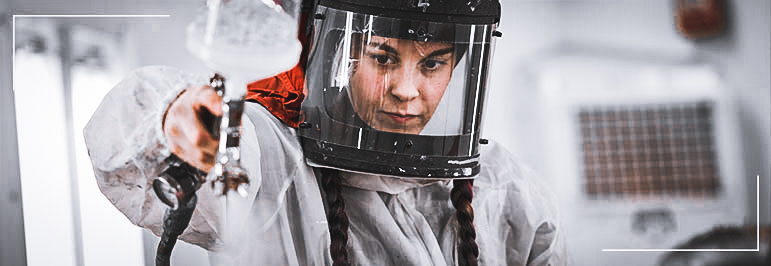Automotive Collision Repair Technology

Automotive Collision Repair Technology - AAS
Love cars and want to make fixing them your career? Bellingham Technical College’s Automotive Collision Repair Technology program will prepare you for a career as an automotive collision repair technician, automotive glass specialist, painter, or auto body repair shop manager. You will be trained for all aspects of automotive repair, using the latest technological processes and equipment in our full-service shop. Your training will include trade-specific skills, such as how to repair and refinish damaged vehicles.
BTC’s Auto Collision Repair program will give you hands-on instruction that will earn you top jobs with employers such as independent automotive repair shops, car detailing shops, automotive manufacturers, automotive recyclers, and more.
The Auto Collision Repair Technology program is an I-CAR Industry Training Alliance member.
Employment Information
Data are provided on a program (not credential) level
100% BTC graduate placement rate1
$51,269 starting annual wage2
$72,550 average annual wage2
$89,286 potential annual wage2
Entry Information
When Can I Start?
This program admits students once a year, in the Fall quarter.
What are the Minimum Entry Requirements?
A completed college admissions application and placement in English and math. BTC uses a Guided Self-Placement process to help you choose the best starting point for your English and math courses. Your selections will determine whether you begin with program coursework or complete prerequisites classes first.
To get started or for help determining your English and math placement, contact the Outreach department at Outreach@btc.edu.
- A driver’s license is NOT required to enroll in the program.
- Driving citations will not restrict, or prevent students from enrolling in the Automotive Collision Repair Technology Program; however, citations may prevent some internship and/or employment opportunities.
What are My Next Steps?
Classes
Select your start year to see a typical class schedule:
Total Program Credits: 108
Quarter 1
CRT 101 Introduction to Shop Safety 3 CR CRT 103 New Technology and Exterior Trim 3 CR CRT 133 Alternative Exterior Panel Replacement 4 CR CRT 201 Advanced Collision Concepts 1 5 CR CRT 221 Advanced Collision Concepts 2 5 CR Quarter 2
CRT 121 Removable Panels and Glass 3 CR CRT 131 Ferrous Auto Collision Welding 4 CR CRT 132 Non-Ferrous Auto Collision Welding 5 CR AMATH 100 Applied Occupational Math 5 CR or higher Quarter 3
CRT 123 Auto Collision Exterior Lighting & Plastics 4 CR CRT 202 Admin Industry Simulation 6 CR CRT 222 Structural Industry Simulation 6 CR AENGL 100 Applied English 5 CR or higher Quarter 4
CRT 102 Automotive Refinishing Basics 10 CR CRT 122 Non-Structural Body Repair 8 CR Quarter 5
CRT 203 Non- Structural Industry Simulation 6 CR CRT 223 Refinish Industry Simulation 6 CR CMST& 210 Interpersonal Communication 5 CR OR PSYC& 100 General Psychology 5 CR OR SOC& 101 Introduction to Sociology 5 CR Quarter 6
CRT 231 Final Industry Certification 2 CR CRT 232 Weld Certification Aluminum 3 CR CRT 233 Weld Certification Steel 3 CR CRT 234 Field-Based Experiences 7 CR
Program Outcomes
After successfully completing the AAS degree, students will be able to:
- Use basic industry tools, equipment and hazardous materials safely.
- Diagnose and repair basic non-structural auto body damage to I-CAR standards.
- Assess damaged vehicles and perform structural auto body repairs to I-CAR standards.
- Diagnose and repair various types of plastic and composites used in the automotive industry.
- Refinish various substrates to pre-accident condition.
- Produce aluminum GMAW welds to I-CAR.
- Produce steel GMAW welds to I-CAR.
Employment Outlook
Employment opportunities in the automotive collision repair industry are expected to grow along with the demand for qualified auto body technicians. Due to rapid changes in technology getting formal skills training in automotive body repair will better qualify and individual for employment.
BTC’s Auto Collision Repair program will give you the hands-on instruction that employers are looking for. Program graduates can work as automotive body technicians for independent auto body repair shops, automobile or truck dealers or companies who specialize in body repairs and painting. Opportunities may also exist to work for organizations that maintain their own motor vehicles, such as trucking companies and automobile rental companies, automotive dealerships, automotive manufacturing plants, automotive recyclers, automotive parts and plastics supply shops, independent collision repair shops, detailing shops, aircraft detail and repair shops, boat manufacturers, and industrial manufacturing plants.
Potential positions include automotive repair technician, automotive glass specialist, automotive painter, auto body supply salesperson or body shop manager.
Faculty & Support

Andrew Riggs
Automotive Collision Repair TechnologyContacts
If you have questions about this program or want help with the admissions steps to Bellingham Technical College, please email outreach@btc.edu.
Current students wanting academic planning and support, can connect with the program Instructor(s) or email TransportationNav@btc.edu
